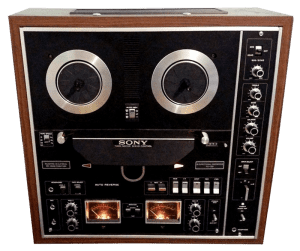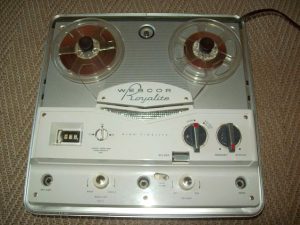So the question begs… why reel-to-reel? It’s an old technology, the machines are large and heavy, the tape is expensive, and most machines need work. Here’s the reason:

Reel-to-reel tape machines are fully analog recording devices, and every – and I mean EVERY – record made prior to about 1981 when Sony introduced the first digital recording unit, was recorded on a reel-to-reel tape recorder.
Fast forward to today, and vinyl has made a big comeback. Reel-to-reel decks are also experiencing a resurgence due to their warm sound quality and the ability to make ‘mix tapes’. Audiophiles are enjoying 1:1 copies of master recordings from a number of online companies, giving better sound quality than records. Horch House out of Austria is about to introduce a brand new reel-to-reel tape deck.
For the purposes of discussion, this section of the website will concentrate on consumer reel-to-reel tape recorders, but almost all of the information can also apply to higher end multitrack studio machines and mastering decks.
Reel History
1920s: The reel-to-reel tape recorder was invented in Germany in the late 1920s. Tapes were made by binding ferrite oxide to a long paper strip that was then magnetized by a tape head. Early reel-to-reel tape was made of paper and later from plastic based strip, which is much more durable.

1950s: Early tape recorders were made with vacuum tubes and were mono (single channel). By the mid 1950s, two-channel (stereo) machines were produced. American crooner Bing Crosby invested into the Ampex Corporation, which was a key player in the development of high quality reel-to-reel tape decks. Early Ampex tube recorders are highly valued to this day, and refurbished studio machines can sell for top dollar.
Advancements in technology (solid state circuits, direct drive motors and other refinements) made reel-to-reel decks more reliable and the frequency response improved. Every professional recording made prior to the digital revolution in the 1980s was made on a form of reel-to-reel tape recorder, so the sound quality of RTR was excellent even in the 1950s.
1970s: Consumer reel-to-reel popularity was loosing favor to cheaper and more convenient cassette decks.
1980s: Most manufacturers discontinued reel-to-reel tape recorders as the digital revolution took over. Teac/Tascam and Otari are the last R2R brands standing.
2010s: The analog revival sees a huge resurgence in vintage stereo equipment, primarily with vinyl recordings. Reel-to-reels are, once again, the prized component of serious audiophiles. Musicians and recording technicians discover the subtle sound qualities available only through analog recording technologies. Studio equipment, long neglected in corners and backrooms, is brought back into service.
2016: Horch House is set to launch a new line of consumer reel-to-reel tape decks.
The Analog Revival
But they said digital was the future! Sorry, no. That was 1985 and this is now – and analog is the future! Why reel-to0-reel?
- That warm sound that cannot be recreated with a CD or MP3
- Digital splatter – that thing that happens when you exceed the headroom of a digital recording device – can ruin a digital recording
- Tape colors the recording sound you’re recording, which sounds so much better
- You simply can’t turn a digital recording into an analog playback
- Finally, let’s face it – there’s something really sexy about slow spinning reels, be it for a home stereo or in a studio.
